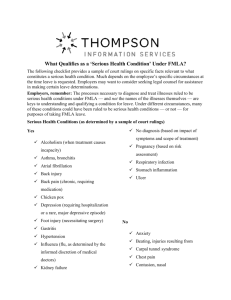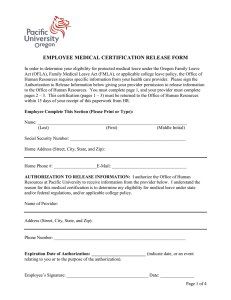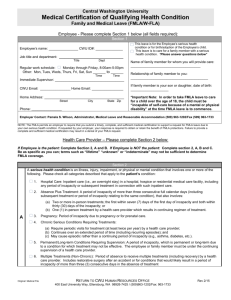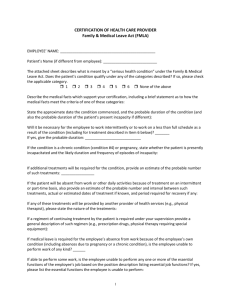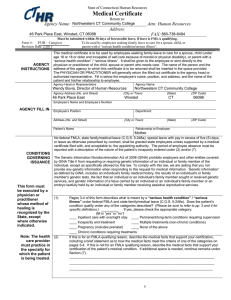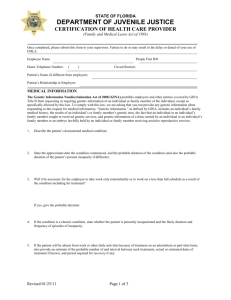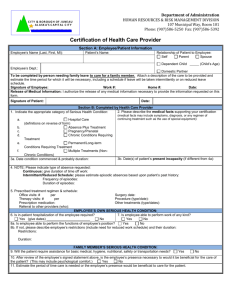Medical Certificate
advertisement
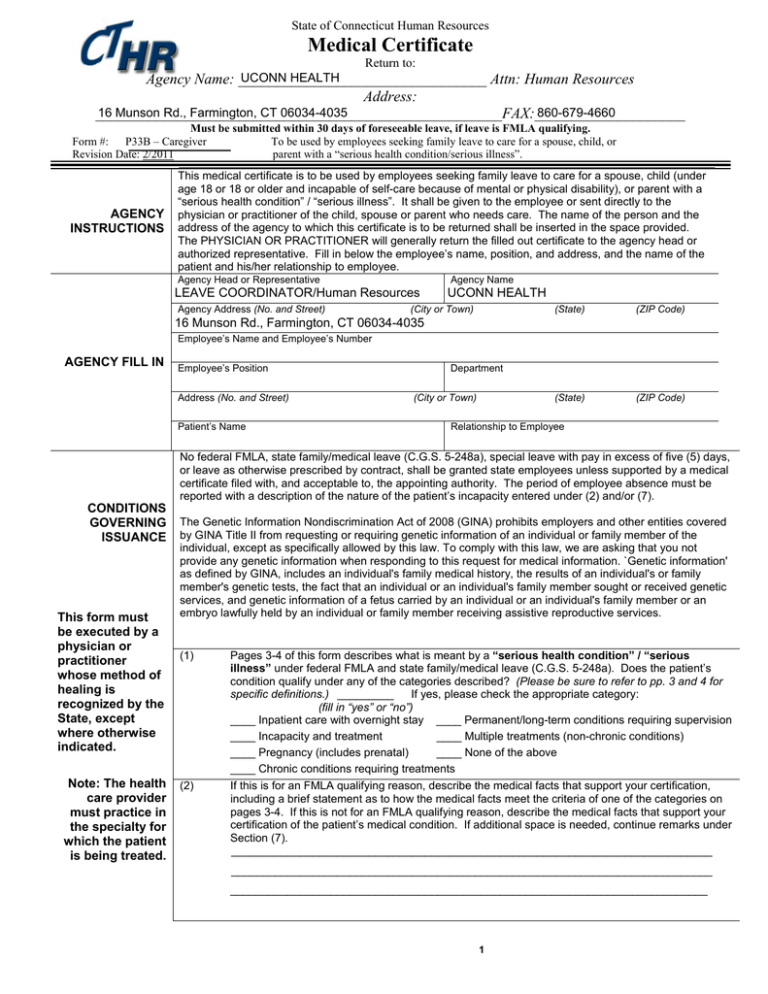
State of Connecticut Human Resources Medical Certificate Return to: UCONN HEALTH Agency Name: _________________________________ Attn: Human Resources Address: 16 Munson Rd., Farmington, CT 06034-4035 860-679-4660 ______________________________________________________FAX:____________________ Must be submitted within 30 days of foreseeable leave, if leave is FMLA qualifying. Form #: P33B – Caregiver To be used by employees seeking family leave to care for a spouse, child, or parent with a “serious health condition/serious illness”. Revision Date: 2/2011 AGENCY INSTRUCTIONS This medical certificate is to be used by employees seeking family leave to care for a spouse, child (under age 18 or 18 or older and incapable of self-care because of mental or physical disability), or parent with a “serious health condition” / “serious illness”. It shall be given to the employee or sent directly to the physician or practitioner of the child, spouse or parent who needs care. The name of the person and the address of the agency to which this certificate is to be returned shall be inserted in the space provided. The PHYSICIAN OR PRACTITIONER will generally return the filled out certificate to the agency head or authorized representative. Fill in below the employee’s name, position, and address, and the name of the patient and his/her relationship to employee. Agency Head or Representative Agency Name LEAVE COORDINATOR/Human Resources Agency Address (No. and Street) UCONN HEALTH (City or Town) (State) (ZIP Code) (State) (ZIP Code) 16 Munson Rd., Farmington, CT 06034-4035 Employee’s Name and Employee’s Number AGENCY FILL IN Employee’s Position Address (No. and Street) Patient’s Name Department (City or Town) Relationship to Employee No federal FMLA, state family/medical leave (C.G.S. 5-248a), special leave with pay in excess of five (5) days, or leave as otherwise prescribed by contract, shall be granted state employees unless supported by a medical certificate filed with, and acceptable to, the appointing authority. The period of employee absence must be reported with a description of the nature of the patient’s incapacity entered under (2) and/or (7). CONDITIONS GOVERNING ISSUANCE This form must be executed by a physician or practitioner whose method of healing is recognized by the State, except where otherwise indicated. Note: The health care provider must practice in the specialty for which the patient is being treated. The Genetic Information Nondiscrimination Act of 2008 (GINA) prohibits employers and other entities covered by GINA Title II from requesting or requiring genetic information of an individual or family member of the individual, except as specifically allowed by this law. To comply with this law, we are asking that you not provide any genetic information when responding to this request for medical information. `Genetic information' as defined by GINA, includes an individual's family medical history, the results of an individual's or family member's genetic tests, the fact that an individual or an individual's family member sought or received genetic services, and genetic information of a fetus carried by an individual or an individual's family member or an embryo lawfully held by an individual or family member receiving assistive reproductive services. (1) (2) Pages 3-4 of this form describes what is meant by a “serious health condition” / “serious illness” under federal FMLA and state family/medical leave (C.G.S. 5-248a). Does the patient’s condition qualify under any of the categories described? (Please be sure to refer to pp. 3 and 4 for specific definitions.) _________ If yes, please check the appropriate category: (fill in “yes” or “no”) ____ Inpatient care with overnight stay ____ Permanent/long-term conditions requiring supervision ____ Incapacity and treatment ____ Multiple treatments (non-chronic conditions) ____ Pregnancy (includes prenatal) ____ None of the above ____ Chronic conditions requiring treatments If this is for an FMLA qualifying reason, describe the medical facts that support your certification, including a brief statement as to how the medical facts meet the criteria of one of the categories on pages 3-4. If this is not for an FMLA qualifying reason, describe the medical facts that support your certification of the patient’s medical condition. If additional space is needed, continue remarks under Section (7). _____________________________________________________________________________ _____________________________________________________________________________ ____________________________________________________________________________ 1 (3) (a) Answer the following: 1. The approximate date the condition commenced. ______________________________ 2. The probable duration of the condition. _____________________________________ 3. The probable duration of the patient’s present incapacity (if different from (3)(a) 2. above). _____________________________________________________________________________________ 4. The date of the patient’s most recent examination for the condition. ________________ (b) If condition is a “chronic condition” (as checked off under Section (1)), state whether the patient is presently incapacitated and the likely duration and frequency of episodes of incapacity: _____Patient ____ is ____ is not presently incapacitated. (check one) Going forward, estimate the: ____Duration of episodes of incapacity = _______________ (hours or days, etc.) ____Frequency of episodes of incapacity = _____________ (no. of times per week or month, etc.) (4) (a) If additional treatments will be required for the condition, provide: ____ An estimate of the probable number of such treatments. ______________________ ____ An estimate of the probable interval between such treatments. _________________ ____ An actual or estimated dates of treatment, if known. __________________________ ____ Period required for recovery, if any. _______________________________________ (b) If any of these treatments will be provided by another provider of health services (e.g., physical therapist), please state the nature of the treatment and period of time covered. _________________________________________________________________________ _________________________________________________________________________ (c) If a regiment of continuing treatment by the patient is required under your supervision, provide a general description of such regiment (e.g., prescription drugs, physical therapy requiring special equipment). _________________________________________________ TO BE FILLED IN BY ATTENDING PHYSICIAN OR PRACTITIONER _________________________________________________________________________ (5) (a) Does the patient require assistance for basic medical or personal needs or safety, or for transportation? (Please print legibly.) (fill in “yes” or “no”) (b) If no, would the employee’s presence to provide psychological comfort be beneficial to the patient or assist in the patient’s recovery? (fill in “yes” or “no”) (c) If the patient will need care only intermittently or on a part-time basis, please indicate the probable duration and frequency of this need. _________________________________________________________________________ _________________________________________________________________________ (6) The caregiver/employee will be able to return to work on __________________ (date). (7) Additional remarks: Name of Physician or Practitioner AND Physician or Practitioner License Number (please type or print) Address (No. and Street) (City or Town) (State) Signed (Physician or Practitioner) Date Telephone 2 (ZIP Code) FEDERAL FMLA: Under the federal FMLA, “Serious Health Condition” is defined as an illness, injury, impairment, or physical or mental condition that involves: Any period of incapacity or treatment related to inpatient care (i.e., an overnight stay in a hospital, hospice, residential facility, OR Continuing treatment by a health care provider. “Continuing treatment” by a health care provider includes any one or more of the following: 1) Incapacity and Treatment: A period of incapacity of more than three consecutive full calendar days and any subsequent treatment or period of incapacity relating to the same condition, that also involves: Treatment two or more times within 30 days of the first day of incapacity, unless extenuating circumstances exist, OR Treatment by a health care provider on at least one occasion which results in a regimen of continuing treatment under the supervision of the health care provider. Treatment means an in-person visit to a health care provider. The first (or only) in-person treatment visit must take place within seven (7) days of the first day of incapacity. 2) Pregnancy: Any period of incapacity due to pregnancy, or for prenatal care. 3) Chronic Conditions Requiring Treatments: Any period of incapacity or treatment for such incapacity due to a chronic condition which: Requires periodic visits for treatment by a health care provider or by a nurse physician’s assistant under direct supervision of health care provider; Continues over an extended period of time (including recurring episodes of a single underlying condition); AND May cause episodic rather than a continuing period of incapacity. Examples: asthma, diabetes, epilepsy. 4) Permanent/Long-term Conditions: A period of incapacity, which is permanent or long-term due to a condition for which treatment may not be effective. The employee or family member must be under the continuing supervision of, but need not be receiving active treatment by, a health care provider. Examples: Alzheimer’s, a severe stroke, or the terminal stages of a disease. 5) Multiple Treatments (Non-Chronic Conditions): Any period of absence to receive treatments (including any period of recovery therefrom) by a health care provider or by a provider of health care services under orders of, or on referral by, a health care provider, either for restorative surgery after an accident or other injury, or for a condition that would likely result in a period of incapacity of more than three consecutive calendar days in the absence of medical intervention or treatment. Examples: cancer (chemotherapy, radiation, etc.) severe arthritis (physical therapy), and kidney disease (dialysis). Note: Substance abuse may be a serious health condition if the conditions mentioned above are met. However, FMLA leave may only be taken for treatment for substance abuse by a health care provider or by a provider of health care services on referral by a health care provider. On the other hand, absence because of the employee’s use of the substance, rather than for treatment, does not qualify for FMLA leave. Please Note: For the purposes of federal FMLA the following terms are defined to mean: “Incapacity” – inability to work, attend school or perform other regular daily activities due to the serious health condition, treatment therefore, or recovery therefrom. “Treatment” – includes examinations to determine if a serious health condition exists and evaluations of the condition. It does not include routine physical examinations, eye examinations, or dental examinations. A “regime of continuing treatment” – includes, for example, a course of prescription medication (e.g. an antibiotic) or therapy requiring special equipment to resolve or alleviate the health condition. It does not include the taking of over-the-counter medications such as aspirin, antihistamines, or salves, or bed-rest, drinking fluids, exercise, and other similar activities that can be initiated without a visit to a health care provider. “Intermittent Leave” – is leave taken in separate blocks of time due to a single qualifying reason. “Reduced Leave Schedule” – is leave schedule that reduces an employee’s usual number of working hours per work week or hours per workday. It is a change in the employee’s schedule for a period of time, normally from full-time to part-time. 3 STATE FAMILY / MEDICAL LEAVE (C.G.S. 5-248a): Under the state’s family/medical leave law, “Serious Illness” is defined as an illness, injury, impairment or physical or mental condition that involves: Inpatient care in a hospital, hospice, or residential care facility; OR Continuing treatment or continuing supervision by a health care provider [C.G.S. 5-248a(c) and CT State Regulation 5-248b-1(d)]. 4
